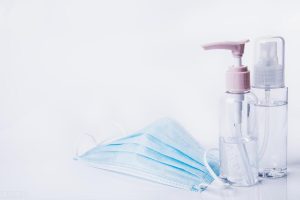In the medical field, disinfection is a vital task that aims to kill or remove the vectors that transmit pathogenic microorganisms to ensure that the environment and items are harmless. In contrast, sterilization is a more thorough process that kills all microorganisms, including bacterial spores. To achieve the goals of disinfection and sterilization, various disinfectants and sterilants are used. These preparations are designed to effectively kill microorganisms.

Types and effectiveness of disinfectants
Disinfectants can be divided into different types based on their effectiveness in killing microorganisms. Highly effective disinfectants kill mycobacteria, fungi, viruses and their vegetative forms. Medium-efficiency disinfectants are mainly used to kill propagules and lipophilic viruses, while low-efficiency disinfectants are suitable for killing propagules and some lipophilic viruses. Choosing the appropriate type of disinfectant is an important factor in ensuring disinfection effectiveness.
Disinfection noun explanation
In the field of disinfection, there are some common terms that need to be understood. Disinfection of epidemic areas refers to the disinfection of places where sources of infection exist or have existed to prevent the spread of diseases. Disinfection at any time refers to the timely disinfection of potentially contaminated environments and items when there is a source of infection. Terminal disinfection refers to thorough disinfection performed after the source of infection leaves the foci to ensure that there are no remaining pathogenic microorganisms. Preventive disinfection is the disinfection of items and places that may be contaminated by pathogenic microorganisms to prevent the spread of disease.
Factors affecting disinfection effectiveness
Disinfection effect is affected by many factors. The first is the resistance of pathogens. Different pathogenic microorganisms have different resistances to disinfectants. The second is the mode of transmission. Different pathogenic microorganisms spread in different ways, and corresponding disinfection strategies need to be adopted. Disinfection factors are also important factors that affect the disinfection effect, including the type, concentration and usage of disinfectants. In addition, different surface properties and structures of disinfected objects also require different treatments. The humidity, temperature and ventilation conditions of the disinfection environment will also affect the disinfection effect. In addition, the length of time the disinfectant is in contact with the object being treated has a significant impact on effectiveness. Finally, operator training and operating practices will also have an impact on disinfection results.

Resistance of pathogens to common disinfection agents
Different types of pathogenic microorganisms show different resistance to common disinfection factors. Spores are highly resistant and require strong disinfectants to kill them. Mycobacteria are relatively sensitive to some highly effective disinfectants. Hydrophilic viruses or small viruses are relatively easy to destroy with some ineffective disinfectants. Fungal resistance to disinfectants varies by species### Common disinfection methods
Here are some common disinfection methods:
Physical disinfection methods:
Thermal disinfection: Use high temperature to kill pathogenic microorganisms, such as steam sterilizers, ovens, etc.
Radiation Disinfection: The use of ultraviolet radiation or ionizing radiation to kill microorganisms.
Filtration sterilization: Microorganisms are filtered out through a filter, often used for liquid sterilization.
Chemical disinfection methods:
Chloride disinfectants: such as bleaching powder, chlorine-containing disinfectants, etc., commonly used for disinfecting water, surface cleaning, etc.
Alcohol disinfectants: such as ethanol, isopropyl alcohol, etc., are commonly used for hand disinfection.
Aldehyde disinfectants: such as glutaraldehyde, glucuronic acid, etc., are commonly used for disinfection of medical equipment.
Hydrogen peroxide disinfectant: Such as hydrogen peroxide solution, commonly used for sterilization and disinfection.
Biological disinfection methods:
Enzyme Disinfection: The use of specific enzymes to kill microorganisms.
Biological control agents: Use of specific microorganisms to inhibit the growth of other microorganisms.
Choosing an appropriate disinfection method depends on the object of disinfection, the type of pathogenic microorganisms, disinfection requirements and conditions and other factors. In medical environments, a combination of disinfection methods is often used to improve disinfection effectiveness. In addition, correct operating procedures and safety measures need to be followed during the disinfection process to ensure the effectiveness of disinfection and the safety of operators.